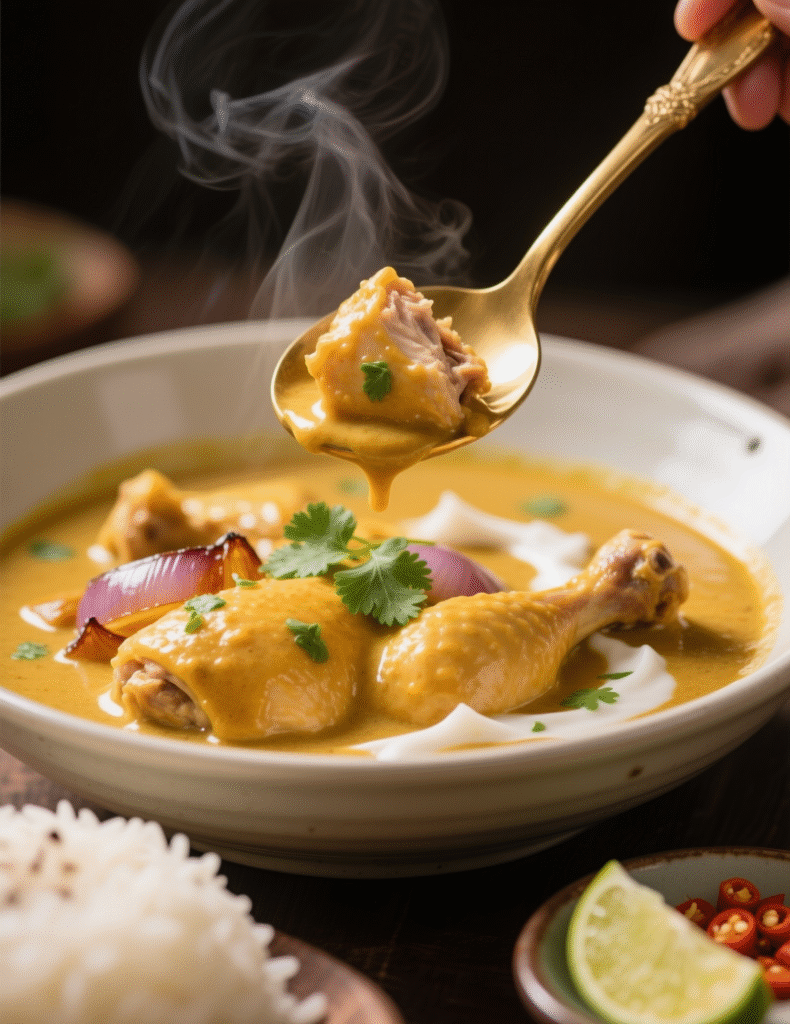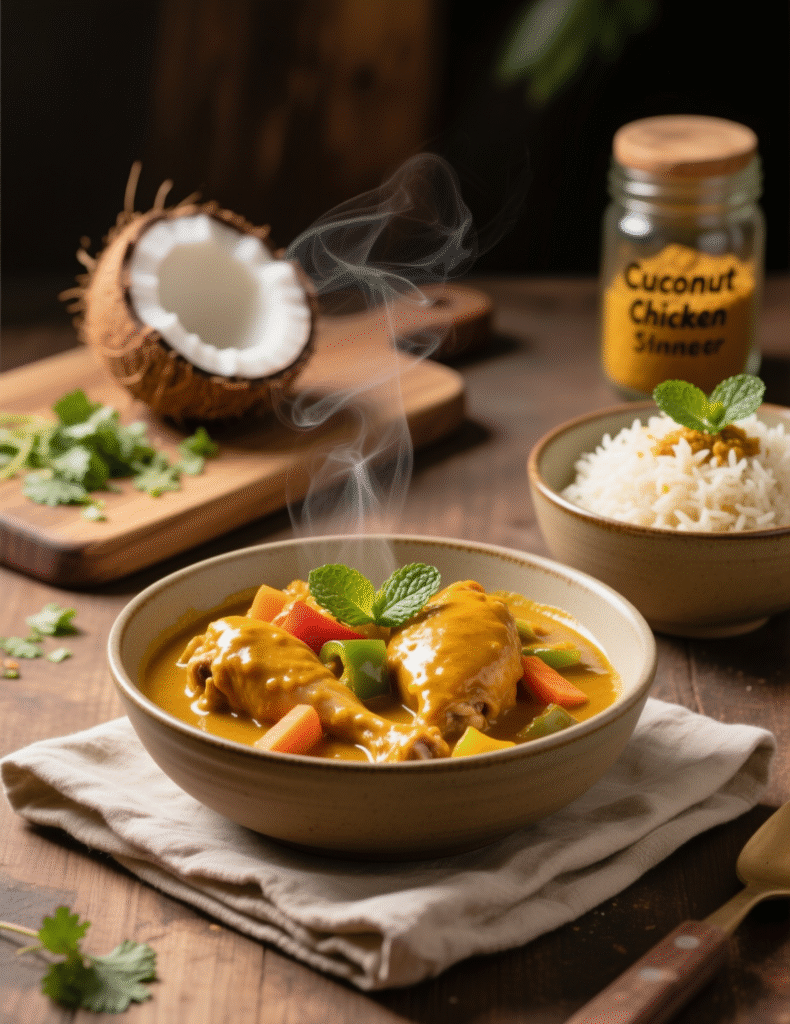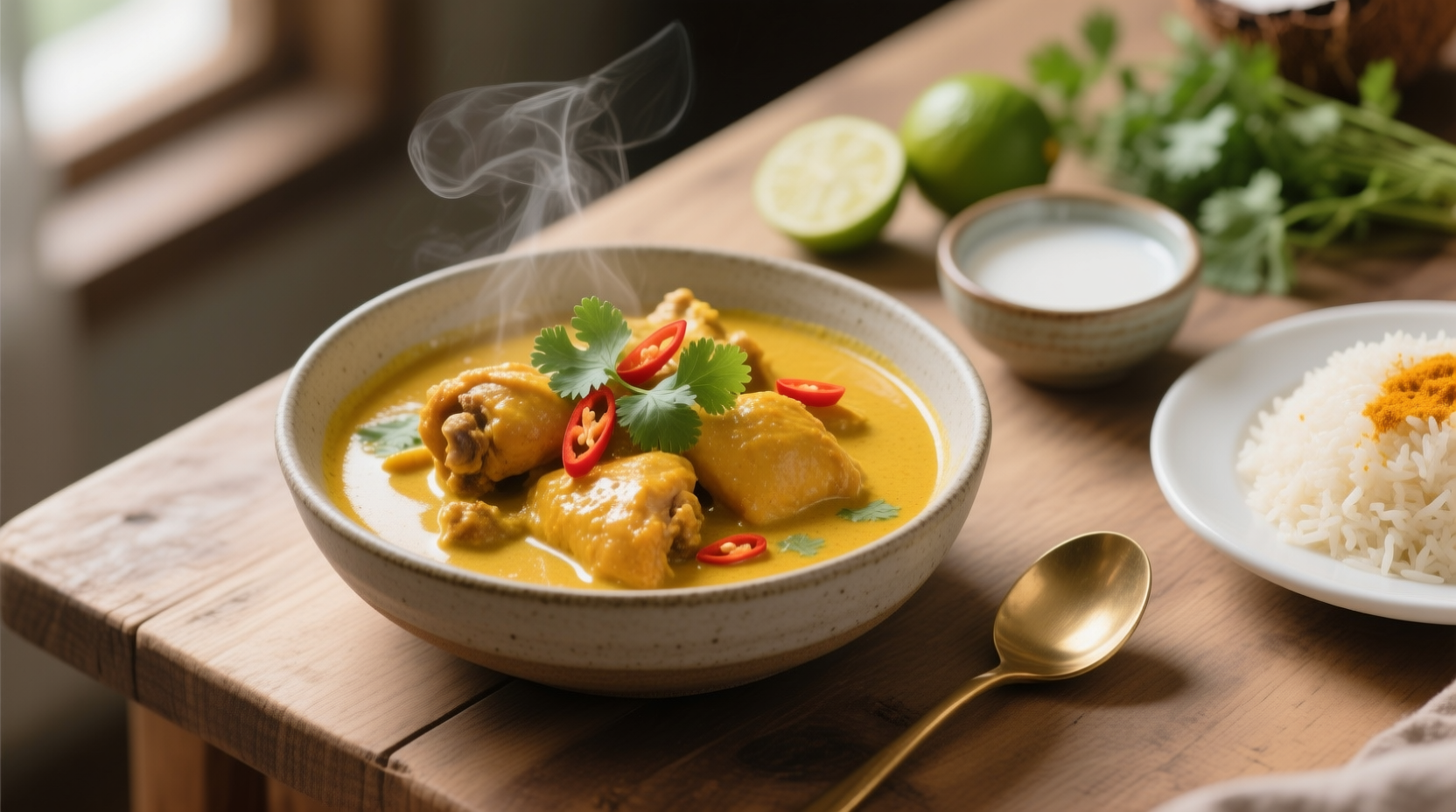If there’s one dish that can take over a dinner table like it owns the place, it’s coconut chicken curry.
Not the heavy, over-oiled, taste-bud-numbing kind.
I’m talking about the silky, aromatic, “I’ll-just-have-one-more-bite” curry that somehow disappears faster than you made it.
This isn’t just about putting chicken in coconut milk and calling it a night.
It’s about layering flavor like a chef who knows exactly how to make cumin and ginger become best friends.
And if you get the balance right? You’re not just cooking dinner—you’re winning dinner.
Why Coconut Chicken Curry Wins Every Time
Coconut milk brings a creaminess that doesn’t bully your tastebuds into submission.
Instead, it wraps the spice in a blanket of mellow sweetness.
The trick is that the coconut isn’t just there for body—it’s there to lift the flavor of the spices, not drown them.
In restaurant kitchens, chefs talk about “flavor bridges.”
Coconut milk is the bridge between the chili heat and the tang of tomato or lime.
Without it, the curry can feel flat—like a song with no chorus.
According to market research by Mordor Intelligence, global coconut milk demand has surged over 6% annually, partly due to its versatility in savory dishes.
Chefs have caught on, using it in modern fusion curries, plant-based soups, and even reductions for seafood.
But in chicken curry, it finds its true calling.
The Foundation: Picking the Right Chicken
I’ll say it now—chicken breast has no business in a long-simmered curry unless you’re ready for dry, stringy regret.
Use thighs, bone-in if you can.
They hold moisture better and give off a richer flavor during cooking.
If you want the curry to sing from the first bite, marinate the chicken first.
Yogurt, garlic, a pinch of turmeric, maybe a dash of chili.
Even a quick 30-minute soak changes the texture—turns “okay chicken” into “did you brine this in magic?”
Professional kitchens often flash-sear the chicken before adding it to the curry base.
That caramelized edge brings depth.
Skip that step and you’re missing a chance for free flavor.
Building the Curry Base Like a Pro
Curry bases are where amateur cooks and seasoned chefs part ways.
It’s not about dumping spices into coconut milk—it’s about building a base that can stand on its own before the coconut even touches it.
This starts with onions.
Sweat them slowly, not aggressively.
They need to break down until sweet, almost jammy.
Then in goes the garlic and ginger paste—if you burn them, you might as well start over, because bitterness will follow you through every bite.
Spices come next, but not all at once.
Dry spices like cumin, coriander, turmeric, and chili powder should bloom in oil for 20–30 seconds to unlock their volatile oils.
You’ll smell the difference—suddenly the kitchen smells like a market in Goa instead of just… onions.

Coconut Milk: Choosing the Right Kind
There’s a canyon-wide gap between good coconut milk and the cheap, watery kind.
Look for one with 60–70% coconut extract, not “light” versions.
The lower-fat stuff splits easily and leaves your curry looking like someone tried to make soup from leftovers.
Some chefs prefer to mix coconut cream with a splash of water for more control over thickness.
If you want to avoid curdling, add the coconut milk toward the end and simmer gently.
Vigorous boiling will make it separate faster than bad dinner guests leave after the bill arrives.
A trick? Toast a little shredded coconut in a dry pan and stir it in with the milk.
It deepens the nutty undertone without overpowering.
It’s a move I’ve seen Michelin-trained chefs use quietly, like a magician palming a card.
Balancing Spice, Heat, and Sweet
A curry that’s just spicy is boring.
A curry that’s just sweet is cloying.
The magic is in the push and pull between the two.
If your curry feels “muddy,” a squeeze of lime at the end will wake it up.
If it feels too harsh, a teaspoon of brown sugar smooths it out.
Chefs call this “rounding,” and it’s why restaurant curries often feel more complete than homemade ones.
Chili choice matters too.
Fresh green chilies bring a grassy, upfront heat.
Dried red chilies are smoky and mellow—use a mix to keep your flavor notes layered.
The Cooking Process, Step by Step
- Marinate chicken – Thigh pieces with yogurt, garlic, turmeric, chili powder. At least 30 minutes.
- Sear chicken – Medium-high heat, just until browned on the outside. Remove and set aside.
- Build base – Slow-cook onions until golden. Add garlic and ginger paste.
- Bloom spices – Cumin, coriander, turmeric, chili powder, maybe a pinch of cinnamon.
- Add liquids – A splash of chicken stock or water to loosen the paste, then tomatoes or puree.
- Simmer – Let it reduce until thick, flavors concentrated.
- Coconut milk – Stir in, lower the heat, return chicken.
- Finish – Fresh cilantro, squeeze of lime, maybe toasted coconut for garnish.
At every step, taste.
Chefs aren’t psychic—they’re just compulsive tasters.
What you adjust now saves you from an “eh” curry later.

Common Mistakes (and How Pros Avoid Them)
Mistake 1: Overcooking the coconut milk.
Solution: Gentle simmer, never boil hard after it’s in.
Mistake 2: Skipping the spice blooming.
Solution: Always let spices fry in oil—raw spice tastes dusty.
Mistake 3: Thinking salt is just seasoning.
Solution: Salt shapes flavor—add in layers, not all at the end.
Mistake 4: Relying only on heat for excitement.
Solution: Balance with acid, sweet, and umami.
Emerging Trends in Coconut Chicken Curry
Fusion versions are everywhere.
In London, chefs are pairing coconut curry bases with charred leeks and roasted squash for modern menus.
In Southeast Asia, some kitchens are swapping chicken for duck but keeping the same coconut profile.
Plant-based meat alternatives are now being tested in coconut curries for diners avoiding poultry.
Beyond Meat reported a 12% rise in demand for coconut-based curry dishes in plant-forward restaurants.
Still, chicken remains the top protein for this style worldwide.
There’s also a move toward “low-oil” curries in wellness-focused cooking.
Chefs are finding ways to coax flavor from spices without drowning them in fat.
Dry-roasting and stock reductions are becoming more common.
A Chef’s Secret for Depth
If you want your coconut chicken curry to taste like it simmered for hours, cheat a little.
Add a small spoon of fish sauce or anchovy paste into the base.
You won’t taste “fish”—just a deeper, richer umami that makes people wonder what you did.
Some chefs also sneak in a dash of black cardamom.
It’s smoky, almost leathery, and a single pod can transform the whole pot.
Don’t overdo it, though—it’s a background singer, not the lead vocalist.
Serving It Right
Serve coconut chicken curry with something that respects it.
Steamed jasmine rice is classic, but coconut rice doubles down on the theme.
If you want contrast, try roti or paratha—flatbreads that soak up sauce without turning soggy instantly.
A garnish of fresh herbs isn’t just for looks.
Cilantro, mint, or Thai basil changes the aroma at the moment of serving.
That first waft is part of the eating experience—ignore it, and you miss half the pleasure.
Final Word
Coconut chicken curry isn’t just a dish—it’s a masterclass in balance.
Every decision, from the chicken cut to when you add the milk, shapes the outcome.
If you rush, you’ll get “fine.” If you take your time, you’ll get “unforgettable.”
For professionals, the win is in consistency.
Replicate that depth every single time, and diners will follow you from restaurant to restaurant.
For home cooks, it’s about enjoying the process, tasting often, and trusting that good curry waits for no shortcuts.
Now the real question is—will you make it tonight, or will someone else’s kitchen get the glory?
FAQs
What type of chicken is best for coconut chicken curry?
Chicken thighs, preferably bone-in, give richer flavor and stay moist.
Can I use light coconut milk in this recipe?
It’s not ideal—light versions often split and lack creaminess.
How do I stop coconut milk from curdling?
Add it toward the end and simmer gently without boiling hard.
What’s the secret to a flavorful curry base?
Slow-cook onions, bloom spices in oil, and layer flavors gradually.
Can I make coconut chicken curry ahead of time?
Yes, it tastes even better the next day as flavors deepen.
How can I balance a curry that’s too spicy?
Add a splash of coconut milk, sugar, or lime juice to round it out.
Is this curry freezer-friendly?
Yes, store in airtight containers and reheat gently to preserve texture.
Can I make this recipe vegetarian?
Yes, swap chicken for chickpeas, tofu, or mixed vegetables.
What side dishes go best with coconut chicken curry?
Steamed jasmine rice, coconut rice, or soft flatbreads like roti.
How long does it take to make this curry?
About 45–60 minutes, including prep and marination time.

Mariana is a passionate home cook who creates delicious, easy-to-follow recipes for busy people. From energizing breakfasts to satisfying dinners and indulgent desserts, her dishes are designed to fuel both your body and hustle.
When she’s not in the kitchen, she’s exploring new flavors and dreaming up her next recipe to share with the Foodie Hustle community.

